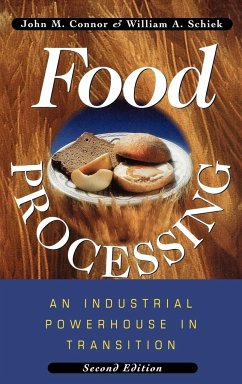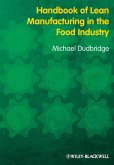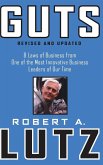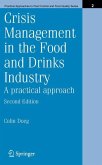- Gebundenes Buch
- Merkliste
- Auf die Merkliste
- Bewerten Bewerten
- Teilen
- Produkt teilen
- Produkterinnerung
- Produkterinnerung
Die zweite Auflage des Buches zu Wachstum, ökonomischer Entwicklung und zum Geschäftsmanagement der Nahrungsmittelindustrie der Vereinigten Staaten - eines der größten US-amerikanischen Industriezweige. Mit aktuellsten, übersichtlich tabellierten Informationen zur Produktentwicklung, Biotechnologie und Globalisierung. Äußerst interessant auch für europäische Märkte, die die US-Entwicklungen verfolgen wollen.
Andere Kunden interessierten sich auch für
![Intelligent Agrifood Chains and Networks Intelligent Agrifood Chains and Networks]() Intelligent Agrifood Chains and Networks205,99 €
Intelligent Agrifood Chains and Networks205,99 €![Sustainability in the Food Industry Sustainability in the Food Industry]() Sustainability in the Food Industry260,99 €
Sustainability in the Food Industry260,99 €![Handbook of Lean Manufacturing in the Food Industry Handbook of Lean Manufacturing in the Food Industry]() Michael DudbridgeHandbook of Lean Manufacturing in the Food Industry95,99 €
Michael DudbridgeHandbook of Lean Manufacturing in the Food Industry95,99 €![Guts Guts]() Robert A. LutzGuts26,99 €
Robert A. LutzGuts26,99 €![Fedex Delivers Fedex Delivers]() Madan BirlaFedex Delivers30,99 €
Madan BirlaFedex Delivers30,99 €![Crisis Management in the Food and Drinks Industry: A Practical Approach Crisis Management in the Food and Drinks Industry: A Practical Approach]() Colin DoegCrisis Management in the Food and Drinks Industry: A Practical Approach77,99 €
Colin DoegCrisis Management in the Food and Drinks Industry: A Practical Approach77,99 €![Career Imprints Career Imprints]() Monica C. HigginsCareer Imprints35,99 €
Monica C. HigginsCareer Imprints35,99 €-
-
-
Die zweite Auflage des Buches zu Wachstum, ökonomischer Entwicklung und zum Geschäftsmanagement der Nahrungsmittelindustrie der Vereinigten Staaten - eines der größten US-amerikanischen Industriezweige. Mit aktuellsten, übersichtlich tabellierten Informationen zur Produktentwicklung, Biotechnologie und Globalisierung. Äußerst interessant auch für europäische Märkte, die die US-Entwicklungen verfolgen wollen.
Produktdetails
- Produktdetails
- Verlag: Wiley & Sons
- 2. Aufl.
- Seitenzahl: 688
- Erscheinungstermin: 23. Mai 1997
- Englisch
- Abmessung: 240mm x 161mm x 41mm
- Gewicht: 1077g
- ISBN-13: 9780471155157
- ISBN-10: 0471155152
- Artikelnr.: 14916145
- Herstellerkennzeichnung
- Libri GmbH
- Europaallee 1
- 36244 Bad Hersfeld
- gpsr@libri.de
- Verlag: Wiley & Sons
- 2. Aufl.
- Seitenzahl: 688
- Erscheinungstermin: 23. Mai 1997
- Englisch
- Abmessung: 240mm x 161mm x 41mm
- Gewicht: 1077g
- ISBN-13: 9780471155157
- ISBN-10: 0471155152
- Artikelnr.: 14916145
- Herstellerkennzeichnung
- Libri GmbH
- Europaallee 1
- 36244 Bad Hersfeld
- gpsr@libri.de
JOHN M. CONNOR, PhD, is Professor of Agricultural Economics at Purdue University. He has served as head of food manufacturing research in the Economic Research Service of the U.S. Department of Agriculture. WILLIAM A. SCHIEK, PhD, is Assistant Professor of Agricultural Economics at Purdue University. He is a former cooperative relations specialist and research economist with the New York-New Jersey Milk Market Administrator of the U.S. Department of Agriculture's Agricultural Marketing Service.
Aus dem Inhalt:
Introduction; Brief History of the Industries; Processing in the US Food System: Value Added, Employment, Agriculture, Channels of Distribution; Industrial Structure & Business Organization: Size, International Comparisons, Difference in Value Added, Income Multipliers, Numbers & Sizes of Companies, Sales Concentration, Mergers, Profit Performance; Industry Growth: Aggregate Growth - Household, Domestic, & Foreign Demand; Geographic Location: Leading States, Company Locations, Three Types of Food Industries - Supply-Oriented, Demand-Oriented, & Footloose Industries; Input Utilization: Materials, Energy, Labor, Plant & Equipment, Assets, Business Services, Pricing; Procurement Strategies: Managing Input Price Risk, Quantity Risk, & Input Quality, Input Services; Household Demand for Food: Forces Driving Demand, Consumption, Consumer Purchasing Patterns, International Food Expenditure Trends; Distribution Channels for Food; Product and Promotion Strategies; Technological Change and Food Processing: Resources Devoted to R & D, Invention & Innovation, Productivity Growth, New Product Introduction, Issues Affecting Future Technological Change; Globalization Of Food Processing: Imports and Exports, International Trade, International Direct Investment, International Market Strategy, Servicing Foreign Markets, Opportunities and Future Directions; The Futures Of Food Processing.
Introduction; Brief History of the Industries; Processing in the US Food System: Value Added, Employment, Agriculture, Channels of Distribution; Industrial Structure & Business Organization: Size, International Comparisons, Difference in Value Added, Income Multipliers, Numbers & Sizes of Companies, Sales Concentration, Mergers, Profit Performance; Industry Growth: Aggregate Growth - Household, Domestic, & Foreign Demand; Geographic Location: Leading States, Company Locations, Three Types of Food Industries - Supply-Oriented, Demand-Oriented, & Footloose Industries; Input Utilization: Materials, Energy, Labor, Plant & Equipment, Assets, Business Services, Pricing; Procurement Strategies: Managing Input Price Risk, Quantity Risk, & Input Quality, Input Services; Household Demand for Food: Forces Driving Demand, Consumption, Consumer Purchasing Patterns, International Food Expenditure Trends; Distribution Channels for Food; Product and Promotion Strategies; Technological Change and Food Processing: Resources Devoted to R & D, Invention & Innovation, Productivity Growth, New Product Introduction, Issues Affecting Future Technological Change; Globalization Of Food Processing: Imports and Exports, International Trade, International Direct Investment, International Market Strategy, Servicing Foreign Markets, Opportunities and Future Directions; The Futures Of Food Processing.
Aus dem Inhalt:
Introduction; Brief History of the Industries; Processing in the US Food System: Value Added, Employment, Agriculture, Channels of Distribution; Industrial Structure & Business Organization: Size, International Comparisons, Difference in Value Added, Income Multipliers, Numbers & Sizes of Companies, Sales Concentration, Mergers, Profit Performance; Industry Growth: Aggregate Growth - Household, Domestic, & Foreign Demand; Geographic Location: Leading States, Company Locations, Three Types of Food Industries - Supply-Oriented, Demand-Oriented, & Footloose Industries; Input Utilization: Materials, Energy, Labor, Plant & Equipment, Assets, Business Services, Pricing; Procurement Strategies: Managing Input Price Risk, Quantity Risk, & Input Quality, Input Services; Household Demand for Food: Forces Driving Demand, Consumption, Consumer Purchasing Patterns, International Food Expenditure Trends; Distribution Channels for Food; Product and Promotion Strategies; Technological Change and Food Processing: Resources Devoted to R & D, Invention & Innovation, Productivity Growth, New Product Introduction, Issues Affecting Future Technological Change; Globalization Of Food Processing: Imports and Exports, International Trade, International Direct Investment, International Market Strategy, Servicing Foreign Markets, Opportunities and Future Directions; The Futures Of Food Processing.
Introduction; Brief History of the Industries; Processing in the US Food System: Value Added, Employment, Agriculture, Channels of Distribution; Industrial Structure & Business Organization: Size, International Comparisons, Difference in Value Added, Income Multipliers, Numbers & Sizes of Companies, Sales Concentration, Mergers, Profit Performance; Industry Growth: Aggregate Growth - Household, Domestic, & Foreign Demand; Geographic Location: Leading States, Company Locations, Three Types of Food Industries - Supply-Oriented, Demand-Oriented, & Footloose Industries; Input Utilization: Materials, Energy, Labor, Plant & Equipment, Assets, Business Services, Pricing; Procurement Strategies: Managing Input Price Risk, Quantity Risk, & Input Quality, Input Services; Household Demand for Food: Forces Driving Demand, Consumption, Consumer Purchasing Patterns, International Food Expenditure Trends; Distribution Channels for Food; Product and Promotion Strategies; Technological Change and Food Processing: Resources Devoted to R & D, Invention & Innovation, Productivity Growth, New Product Introduction, Issues Affecting Future Technological Change; Globalization Of Food Processing: Imports and Exports, International Trade, International Direct Investment, International Market Strategy, Servicing Foreign Markets, Opportunities and Future Directions; The Futures Of Food Processing.









